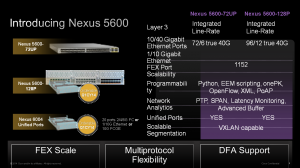What is the new Nexus 5600?
We at Cisco are really excited to introduce the new Cisco Nexus 5600 platform! It is the third generation of industry’s leading Data Center Server-Access Nexus 5000 series of switches. Cisco Nexus 5600 is the successor of industry’s most widely adopted Cisco Nexus 5500 series switches (with over 20,000 customers and 25 million ports shipped) that maintain all the existing Nexus 5500 features such as LAN/SAN convergence, Fabric Extenders (FEX) and Fabric Path.
The new Nexus 5600 was unveiled at CiscoLive Milan in January 2014 with quite a bit of interest
:
Nuts and Bolts
We are introducing 2 models under the 5600 platform:
Cisco Nexus 5672UP – A 1 RU 10/40G Ethernet switch offering wire-speed performance for up to 48 10G Ethernet ports (16 of which are Unified Ports) and 6 true 40G ports.
Cisco Nexus 56128P – A 2 RU 10/40G Ethernet switch offering wire-speed performance for up to 96 10G Ethernet ports (48 of which are Unified Ports) and 8 true 40G ports..
In addition to the existing features of the Nexus 5000, 5600 platform brings new features such as True 40 GE support, VXLAN bridging and routing and Cisco Dynamic Fabric Automation (DFA) innovation. With a latency of about 1 µsec, the 5600 platform is ideal for applications which need low latency. For those of you who need network programmability, the Nexus 5600 supports Cisco OnePK and Openflow.
Why these new features matter
Extensibility with VXLAN support
The Cisco Nexus 5600 with its VXLAN support is very well suited for multi-tenant cloud deployments. In large scale, multi-tenant cloud deployments, there is a need for VMs to migrate across layer-3 boundaries. Traditional VLANs only support about 4000 VLANs which are insufficient in the deployments of thousands of VMs. With the migration need across layer-3 boundaries complexities of layer-3 routers are introduced. To solve the scalability as well as the migration issues VXLAN was developed. For more details on VXLAN, watch the video: http://www.cisco.com/en/US/prod/collateral/switches/ps9441/ps9902/vidoe_fundamentals_vxlan.html
Ease of management with Cisco Dynamic Fabric Automation (DFA)
Our customers are also faced with complex, manual network configurations and have a hard time keeping up with application requirements. To solve these challenges, Cisco has developed an architecture called Dynamic Fabric Automation (DFA) which simplifies management and automation – such as automatic device and fabric configuration, automatic VM deployment, migration and seamless integration of bare-metal and virtualized resources in the data center. The Cisco Nexus 5600 platform with DFA implemented in the hardware as well as software is ideal for the multi-tenant and mixed (physical and virtual) cloud infrastructure.
For more information on DFA, please visit: http://www.cisco.com/en/US/solutions/ns340/ns517/ns224/ns945/dynamic_fabric_automation.html
True 40G support
The difference between a 40G and True 40G port is that you can push an entire 40G flow in the True 40G port and in the normal 40G port, the port really is divided into 4 10G ports via Etherchannels, Thus in the True 40G, you get full 40G bandwidth. The Cisco Nexus 5600 platform switches has True 40G ports, which help in servicing the full 40G flows.
The Big Picture
Cisco has one of the most comprehensive portfolios for the Data Center and Cloud Networking and this Nexus 5600 platform is but one of the pieces of this portfolio. You may want to read this excellent blog, which explains Cisco’s Data Center and Cloud Networking portfolio.
Dear Charuhas,
thanks for the brief intro to this new Nexus model.
However, no words on Layer 3 functionality, IPv6, TRILL and FCoE support. My guess is that, as part of the N5K family, it should support them.
Regards,
Pierre Masy